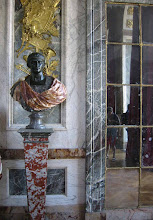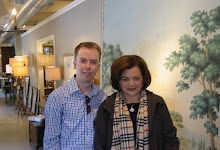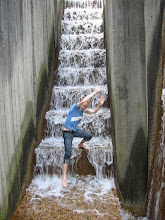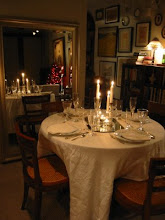
Yet another interesting not so small house from "Small country houses of to-day" is Upmeads, designed by Edgar Wood in 1908.

Like many of the other houses in the book, the house has been lovingly cared for in private hands and remains in nearly the exact condition in which it was built.

Down to the monogram of the original owners who commissioned the house above the front door.

The only change I can see is that a chauffeur's apartment has been sympathetically added on top of the original garage in the forecourt.

The house is shocking for its' base modernity. Can you believe this was built in 1908?

Flat roofed with a boxy plan, it is a hint of what was to come in the future.

Perhaps the house was a bit before its time even as Weaver proclaims in the book "
The house is unusual to the point of oddness".

Even the rear terrace remains intact.

Lets step inside to the original interiors (as far as I can tell). The entryway features beautifully softly groin-vaulted ceilings and herringbone oak floors.

Doors have been installed between the original hall and vestibule in favor of curtains (one of the concessions to the time period).

Weaver makes much of the custom fireplace mantels in the book and they still exist.

I love being able to find these color photos to fill in the blanks left behind by the B&W photos.

The
lincrusta and other wallpaper found throughout the house appear to not be original.

The groin vaulting continues in the 2nd floor hall.

New heating systems have obviously been installed.

More lincrusta upstairs.

Color images and some history found via
Manchester History and interior photography via
Andy Marshall.
 Yet another interesting not so small house from "Small country houses of to-day" is Upmeads, designed by Edgar Wood in 1908.
Yet another interesting not so small house from "Small country houses of to-day" is Upmeads, designed by Edgar Wood in 1908. Like many of the other houses in the book, the house has been lovingly cared for in private hands and remains in nearly the exact condition in which it was built.
Like many of the other houses in the book, the house has been lovingly cared for in private hands and remains in nearly the exact condition in which it was built.  Down to the monogram of the original owners who commissioned the house above the front door.
Down to the monogram of the original owners who commissioned the house above the front door.  The only change I can see is that a chauffeur's apartment has been sympathetically added on top of the original garage in the forecourt.
The only change I can see is that a chauffeur's apartment has been sympathetically added on top of the original garage in the forecourt.  The house is shocking for its' base modernity. Can you believe this was built in 1908?
The house is shocking for its' base modernity. Can you believe this was built in 1908? Flat roofed with a boxy plan, it is a hint of what was to come in the future.
Flat roofed with a boxy plan, it is a hint of what was to come in the future. Perhaps the house was a bit before its time even as Weaver proclaims in the book "The house is unusual to the point of oddness".
Perhaps the house was a bit before its time even as Weaver proclaims in the book "The house is unusual to the point of oddness".  Even the rear terrace remains intact.
Even the rear terrace remains intact. Lets step inside to the original interiors (as far as I can tell). The entryway features beautifully softly groin-vaulted ceilings and herringbone oak floors.
Lets step inside to the original interiors (as far as I can tell). The entryway features beautifully softly groin-vaulted ceilings and herringbone oak floors. Doors have been installed between the original hall and vestibule in favor of curtains (one of the concessions to the time period).
Doors have been installed between the original hall and vestibule in favor of curtains (one of the concessions to the time period). Weaver makes much of the custom fireplace mantels in the book and they still exist.
Weaver makes much of the custom fireplace mantels in the book and they still exist.  I love being able to find these color photos to fill in the blanks left behind by the B&W photos.
I love being able to find these color photos to fill in the blanks left behind by the B&W photos. The lincrusta and other wallpaper found throughout the house appear to not be original.
The lincrusta and other wallpaper found throughout the house appear to not be original. The groin vaulting continues in the 2nd floor hall.
The groin vaulting continues in the 2nd floor hall. New heating systems have obviously been installed.
New heating systems have obviously been installed. More lincrusta upstairs.
More lincrusta upstairs. Color images and some history found via Manchester History and interior photography via Andy Marshall.
Color images and some history found via Manchester History and interior photography via Andy Marshall.







 One so often sees these great old houses in books and I wondered if the house still survived and in what condition. A quick google search found the house did indeed exist and looks more charming than ever!
One so often sees these great old houses in books and I wondered if the house still survived and in what condition. A quick google search found the house did indeed exist and looks more charming than ever! The rear facade has received a few additional windows which in my opinion only help the composition.
The rear facade has received a few additional windows which in my opinion only help the composition. The current owners have added a pavilion in the low garden, seen above, with work by
The current owners have added a pavilion in the low garden, seen above, with work by  Weaver, in his discussion on the house, commended the architects and landscapers for the clever use of a difficult, hilly site. The house was designed long and narrow with a terraced back yard which exists to this day.
Weaver, in his discussion on the house, commended the architects and landscapers for the clever use of a difficult, hilly site. The house was designed long and narrow with a terraced back yard which exists to this day. The gutters were originally piped into this charming lily pond, but I am not sure it still exists in the current garden.
The gutters were originally piped into this charming lily pond, but I am not sure it still exists in the current garden. Here in this side view of the house you get a sense of the hilly siting.
Here in this side view of the house you get a sense of the hilly siting. The new work is well done and who could argue with the addition of a pool!
The new work is well done and who could argue with the addition of a pool! How much easier sleuthing has become with the aid of google!
How much easier sleuthing has become with the aid of google! Some of you may remember last year when I wrote a brief post on
Some of you may remember last year when I wrote a brief post on 
 The house had not yet achieved the cult status it enjoys today and the critique is fair and unbiased. Rather than emphasizing the artistic merits of the design Weaver looks at it from the useage of a family home; A fair analysis as this is what it was designed as (not the museum it is today).
The house had not yet achieved the cult status it enjoys today and the critique is fair and unbiased. Rather than emphasizing the artistic merits of the design Weaver looks at it from the useage of a family home; A fair analysis as this is what it was designed as (not the museum it is today).  While certainly overall a positive look at the house, he points out fatal flaws such as a west-facing kitchen which becomes overheated while preparing dinner. Also that the primary rooms face east and north and remain dark and dreary throughout the day. Certainly not what Morris or Webb intended!
While certainly overall a positive look at the house, he points out fatal flaws such as a west-facing kitchen which becomes overheated while preparing dinner. Also that the primary rooms face east and north and remain dark and dreary throughout the day. Certainly not what Morris or Webb intended! Siting of a house is certainly the most important aspect of design and is so often forgotten in favor of siting the house practically with no regard as to how it is to be used. For example, bedrooms should face east to receive the morning light (or the opposite if so prefered) with living rooms facing south to enjoy the most natural light.
Siting of a house is certainly the most important aspect of design and is so often forgotten in favor of siting the house practically with no regard as to how it is to be used. For example, bedrooms should face east to receive the morning light (or the opposite if so prefered) with living rooms facing south to enjoy the most natural light.  Rooms such as kitchens and baths which are used all day long naturally belong on the northern exposure where natural light is received throughout the day in equal doses. That leads to the problem of ventilation which so often is currently relegated to mechanical systems which never work 1/2 as well as natural ventilation (windows).
Rooms such as kitchens and baths which are used all day long naturally belong on the northern exposure where natural light is received throughout the day in equal doses. That leads to the problem of ventilation which so often is currently relegated to mechanical systems which never work 1/2 as well as natural ventilation (windows). Also included in the article are many photographs of original furniture, Morris-designed, which were left when the house was sold.
Also included in the article are many photographs of original furniture, Morris-designed, which were left when the house was sold.  The 'settle' above shows a number of large leather bound books -don't you wonder what those are? Weaver also raises the question why the minstrel gallery was built above the bench but I think it is so charming that it negates further questioning!
The 'settle' above shows a number of large leather bound books -don't you wonder what those are? Weaver also raises the question why the minstrel gallery was built above the bench but I think it is so charming that it negates further questioning! Always such a pleasure to see a house before and after where the house is so well maintained. I hope you enjoy the
Always such a pleasure to see a house before and after where the house is so well maintained. I hope you enjoy the 




















.jpg)





















.JPG)






































































